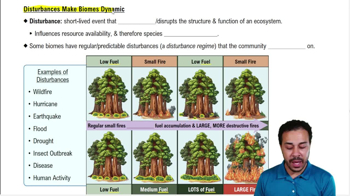Table of contents
- 1. Introduction to Biology2h 40m
- 2. Chemistry3h 40m
- 3. Water1h 26m
- 4. Biomolecules2h 23m
- 5. Cell Components2h 26m
- 6. The Membrane2h 31m
- 7. Energy and Metabolism2h 0m
- 8. Respiration2h 40m
- 9. Photosynthesis2h 49m
- 10. Cell Signaling59m
- 11. Cell Division2h 47m
- 12. Meiosis2h 0m
- 13. Mendelian Genetics4h 44m
- Introduction to Mendel's Experiments7m
- Genotype vs. Phenotype17m
- Punnett Squares13m
- Mendel's Experiments26m
- Mendel's Laws18m
- Monohybrid Crosses19m
- Test Crosses14m
- Dihybrid Crosses20m
- Punnett Square Probability26m
- Incomplete Dominance vs. Codominance20m
- Epistasis7m
- Non-Mendelian Genetics12m
- Pedigrees6m
- Autosomal Inheritance21m
- Sex-Linked Inheritance43m
- X-Inactivation9m
- 14. DNA Synthesis2h 27m
- 15. Gene Expression3h 20m
- 16. Regulation of Expression3h 31m
- Introduction to Regulation of Gene Expression13m
- Prokaryotic Gene Regulation via Operons27m
- The Lac Operon21m
- Glucose's Impact on Lac Operon25m
- The Trp Operon20m
- Review of the Lac Operon & Trp Operon11m
- Introduction to Eukaryotic Gene Regulation9m
- Eukaryotic Chromatin Modifications16m
- Eukaryotic Transcriptional Control22m
- Eukaryotic Post-Transcriptional Regulation28m
- Eukaryotic Post-Translational Regulation13m
- 17. Viruses37m
- 18. Biotechnology2h 58m
- 19. Genomics17m
- 20. Development1h 5m
- 21. Evolution3h 1m
- 22. Evolution of Populations3h 52m
- 23. Speciation1h 37m
- 24. History of Life on Earth2h 6m
- 25. Phylogeny2h 31m
- 26. Prokaryotes4h 59m
- 27. Protists1h 12m
- 28. Plants1h 22m
- 29. Fungi36m
- 30. Overview of Animals34m
- 31. Invertebrates1h 2m
- 32. Vertebrates50m
- 33. Plant Anatomy1h 3m
- 34. Vascular Plant Transport2m
- 35. Soil37m
- 36. Plant Reproduction47m
- 37. Plant Sensation and Response1h 9m
- 38. Animal Form and Function1h 19m
- 39. Digestive System10m
- 40. Circulatory System1h 57m
- 41. Immune System1h 12m
- 42. Osmoregulation and Excretion50m
- 43. Endocrine System4m
- 44. Animal Reproduction2m
- 45. Nervous System55m
- 46. Sensory Systems46m
- 47. Muscle Systems23m
- 48. Ecology3h 11m
- Introduction to Ecology20m
- Biogeography14m
- Earth's Climate Patterns50m
- Introduction to Terrestrial Biomes10m
- Terrestrial Biomes: Near Equator13m
- Terrestrial Biomes: Temperate Regions10m
- Terrestrial Biomes: Northern Regions15m
- Introduction to Aquatic Biomes27m
- Freshwater Aquatic Biomes14m
- Marine Aquatic Biomes13m
- 49. Animal Behavior28m
- 50. Population Ecology3h 41m
- Introduction to Population Ecology28m
- Population Sampling Methods23m
- Life History12m
- Population Demography17m
- Factors Limiting Population Growth14m
- Introduction to Population Growth Models22m
- Linear Population Growth6m
- Exponential Population Growth29m
- Logistic Population Growth32m
- r/K Selection10m
- The Human Population22m
- 51. Community Ecology2h 46m
- Introduction to Community Ecology2m
- Introduction to Community Interactions9m
- Community Interactions: Competition (-/-)38m
- Community Interactions: Exploitation (+/-)23m
- Community Interactions: Mutualism (+/+) & Commensalism (+/0)9m
- Community Structure35m
- Community Dynamics26m
- Geographic Impact on Communities21m
- 52. Ecosystems2h 36m
- 53. Conservation Biology24m
48. Ecology
Introduction to Ecology
Problem 8b
Textbook Question
Compare the distribution of the natural terrestrial biomes of eastern North America with the distribution of anthropogenic biomes.
 Verified step by step guidance
Verified step by step guidance1
Identify and define the key terms: 'natural terrestrial biomes' refer to regions defined by their climate, geography, and the types of plants and animals that naturally occur there, while 'anthropogenic biomes' are areas where the natural landscapes have been significantly altered by human activities.
Research and list the major natural terrestrial biomes in eastern North America, such as temperate deciduous forests, coniferous forests, grasslands, and wetlands.
Investigate how human activities have transformed these natural biomes into anthropogenic biomes, focusing on urban areas, croplands, and managed forests.
Compare the original distribution of natural biomes with the current distribution of anthropogenic biomes, noting changes in land use, biodiversity, and ecosystem services.
Discuss the ecological implications of these transformations, including impacts on native species, introduction of invasive species, and changes in carbon and water cycles.
 Verified video answer for a similar problem:
Verified video answer for a similar problem:This video solution was recommended by our tutors as helpful for the problem above
Video duration:
2mPlay a video:
Was this helpful?
Key Concepts
Here are the essential concepts you must grasp in order to answer the question correctly.
Natural Terrestrial Biomes
Natural terrestrial biomes are large ecological areas characterized by distinct climate conditions, flora, and fauna. In eastern North America, these biomes include temperate deciduous forests, grasslands, and wetlands, each supporting unique ecosystems. Understanding these biomes is essential for comparing them to anthropogenic biomes, as they represent the baseline of natural ecological diversity.
Recommended video:
Guided course

Introduction to Terrestrial Biomes
Anthropogenic Biomes
Anthropogenic biomes, or human-altered biomes, are regions where human activity has significantly modified the natural environment. Examples include urban areas, agricultural lands, and industrial zones. These biomes often exhibit reduced biodiversity and altered ecosystem functions compared to their natural counterparts, making it crucial to analyze their distribution in relation to natural biomes.
Recommended video:
Guided course

Introduction to Aquatic Biomes
Biome Distribution
Biome distribution refers to the geographical spread of different biomes across a region, influenced by factors such as climate, soil type, and human impact. In eastern North America, the distribution of natural and anthropogenic biomes can reveal patterns of land use, conservation efforts, and ecological health. Analyzing these distributions helps in understanding the balance between natural ecosystems and human development.
Recommended video:
Guided course

Disturbances Make Biomes Dynamic

 2:54m
2:54mWatch next
Master What is Ecology? with a bite sized video explanation from Jason Amores Sumpter
Start learningRelated Videos
Related Practice































































































